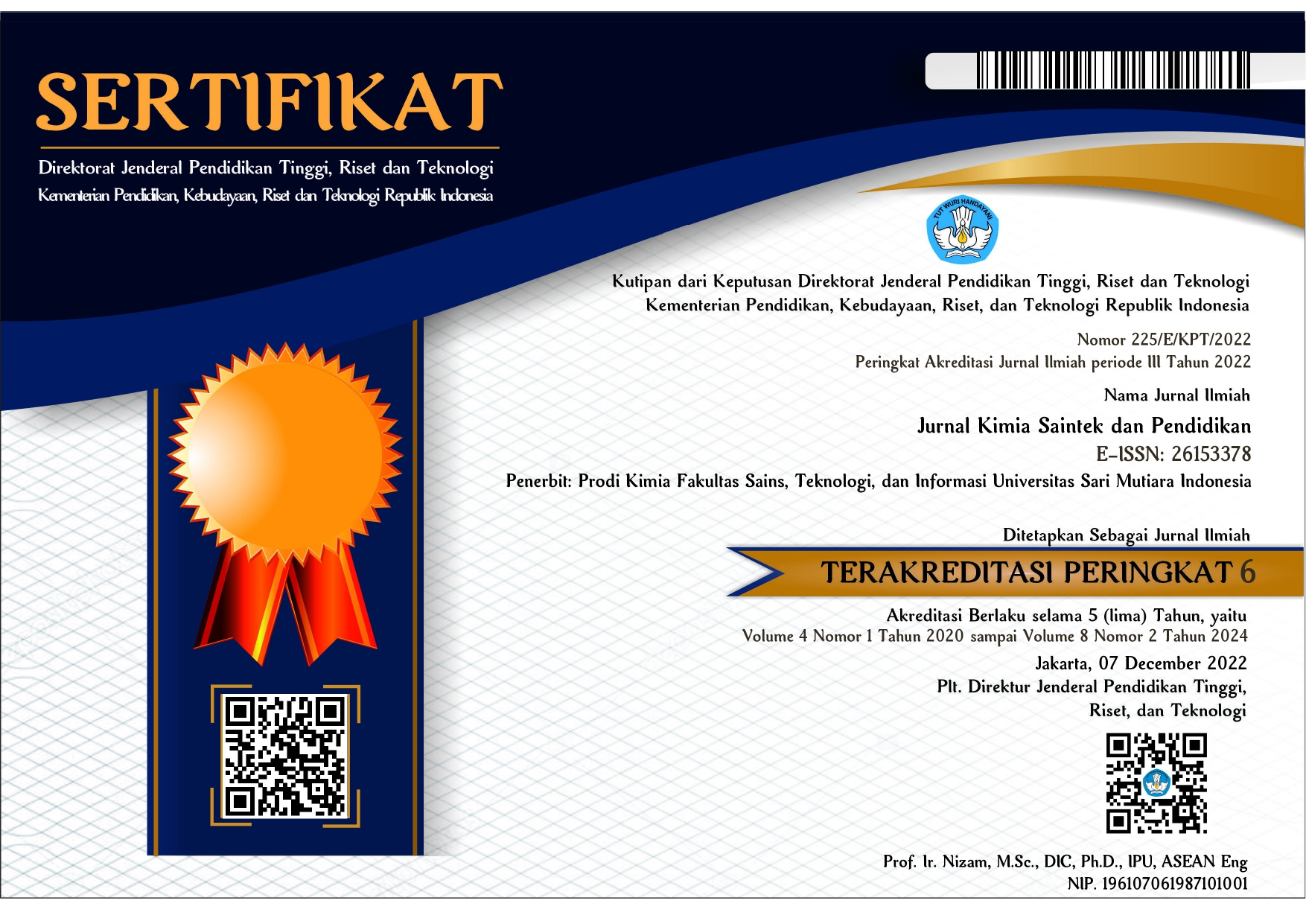UNJUK KERJA NaOH DALAM MEREDUKSI LOGAM BERAT PADA LIMBAH ABU BOILER
DOI:
https://doi.org/10.51544/kimia.v8i1.4950Keywords:
durasi pengadukan, efisiensi reduksi, rasio EDTA: abu boiler, suhu ekstraksiAbstract
Proses pembakaran batu bara menghasilkan emisi berupa gas SO2, NO2, CO, CO2, volatile hydrocarbon (VHC), suspended particulate matter (SPM), serta residu padat berupa abu boiler. Abu boiler mengandung berbagai logam berat beracun, diantaranya tembaga (Cu), kobalt (Co), kromium (Cr), cadmium (Cd) dan timbal (Pb). Penelitian ini bertujuan untuk menentukan efisiensi reduksi logam berat Cu, Co, Cr, Pb, dan total dengan melakukan ekstraksi menggunakan pelarut kimia NaOH dan mengubah logam transisi menjadi kompleks dengan Ethylene diamine tetraacetic acid (EDTA) pada rasio EDTA: abu boiler sebesar 1:2, 1:1, 2:1; durasi pengadukan sebesar 2 dan 4 jam; serta suhu ekstraksi sebesar 25 dan 60 oC. Analisis Inductively Coupled Plasma (ICP) dilakukan untuk mengetahui penurunan kadar logam berat dari ekstrak abu boiler. Hasil penelitian menunjukkan bahwa kondisi ekstraksi berupa rasio EDTA: abu boiler sebesar 2:1, durasi pengadukan sebesar 4 jam, dan suhu ekstraksi sebesar 60 oC dapat menghasilkan persentase penurunan kadar logam berat total tertinggi yang mencapai 77,2% dengan persentase penurunan kadar Co, Cr, Cu, dan Pb secara berturut-turut sebesar 75,4%, 77,9%, 74,5%, dan 81,9%. Penelitian ini diharapkan dapat menjadi rekomendasi bagi penelitian selanjutnya dalam mengeksplor potensi pemanfaatan abu boiler yaitu sebagai bahan campuran aspal, pembuatan batako, dan sebagainya.
Downloads
References
Czech, T., Marchewicz, A., Sobczyk, A. T., Krupa, A., Jaworek, A., & Rosiak, D. 2020. Heavy metals partitioning in fly ashes between various stages of electrostatic precipitator after combustion of different types of coal. Process Safety and Environmental Protection, 133, 18-31.
He, P. J., Zhang, H., Zhang, C. G., & Lee, D. J. (2004). Characteristics of air pollution control residues of MSW incineration plant in Shanghai. Journal of hazardous materials, 116(3), 229-237.
Hou, L., Raveggi, M., Chen, X. B., Xu, W., Laws, K. J., Wei, Y., ... & Birbilis, N. (2016). Investigating the passivity and dissolution of a corrosion resistant Mg-33at.% Li alloy in aqueous chloride using online ICP-MS. Journal of The Electrochemical Society, 163(6), C324.
Kuboňová, L., Langová, Š., Nowak, B., & Winter, F. (2013). Thermal and hydrometallurgical recovery methods of heavy metals from municipal solid waste fly ash. Waste Management, 33(11), 2322-2327.
Leštan, D., Luo, C. L., & Li, X. D. (2008). The use of chelating agents in the remediation of metal-contaminated soils: a review. Environmental pollution, 153(1), 3-13.
Meer, I., & Nazir, R. (2018). Removal techniques for heavy metals from abu boiler. Journal of Material Cycles and Waste Management, 20, 703-722.
Munir, M. (2008). Pemanfaatan abu batubara (fly ash) untuk hollow block yang bermutu dan aman bagi lingkungan (Doctoral dissertation, program Pascasarjana Universitas Diponegoro).
Rattanasak, U., & Chindaprasirt, P. (2009). Influence of NaOH solution on the synthesis of fly ash geopolymer. Minerals Engineering, 22(12), 1073-1078.
Sabubu, T. A. W. (2020). Pengaturan Pembangkit Listrik Tenaga Uap Batubara Di Indonesia Prespektif Hak Atas Lingkungan Yang Baik Dan Sehat. Lex Renaissance, 5(1), 72-90.
Sagaf, M. (2018). Analisa faktor-faktor penyebab perubahan efisiensi boiler jenis pulverized coal fired forced circulation sub-critical pressure menggunakan metode tak langsung. Teknoin, 24(2), 147-158.
Saleem, M. H., Ali, S., Kamran, M., Iqbal, N., Azeem, M., Tariq Javed, M., ... & M. Abdel-Daim, M. (2020). Ethylenediaminetetraacetic acid (EDTA) mitigates the toxic effect of excessive copper concentrations on growth, gaseous exchange and chloroplast ultrastructure of Corchorus capsularis L. and improves copper accumulation capabilities. Plants, 9(6), 756.
Sembiring, M. P., Kaban, J., Bangun, N., & Saputra, E. (2018, April). Lauryl Amine as heavy metal collector of boiler ash from pulp and paper mill waste. In IOP Conference Series: Materials Science and Engineering (Vol. 345, No. 1, p. 012027). IOP Publishing.
Sembiring, M. P., Kaban, J., Bangun, N., & Saputra, E. (2020). Edta utilization for reduction of transition metal content on boiler ash from pulp and paper mill waste.
Slamet & Karina K. I. (2017). Utilization of abu boiler waste for handling ammonia liquid waste.Journal of Chemistry and Packaging, 5(2), 12-19.
Styani, H. D., Slamet, S., & Wirasti, W. (2021, May). Aktivitas Antiinflamasi Partisi Metanol, Etil Asetat, n-Heksan Daun Putri Malu (Mimosa pudica linn). In Prosiding University Research Colloquium (pp. 916-923).
Utama PS, Yamsaengsung R, Sangwichien C. (2013). Optimization using responds surabu boilerce method on silica extraction from palm oil mill abu boiler. InProceedings of the 5th Regional Conference on Chemical Engineering, Pattaya, Thailand, (Vol. 8, No. 2013, pp. 41-44).
Xiao, Z., Yuan, X., Li, H., Jiang, L., Leng, L., Chen, X., ... & Cao, L. (2015). Chemical speciation, mobility and phyto-accessibility of heavy metals in abu boiler and slag from combustion of pelletized municipal sewage sludge. Science of the Total Environment, 536, 774-783.
Yin, K., Li, P., Chan, W. P., Dou, X., & Wang, J.- Y. (2017). Characteristics of heavy metals leaching from MSWI abu boileres in sequential scrubbing processes. Journal of Material Cycles and Waste Management, 20(1), 604–613. doi:10.1007/s10163-017-0631-3.
Downloads
Published
Issue
Section
License
Copyright (c) 2024 Maria Peratenta Sembiring, Rozanna Sri Irianty, Zulfansyah, Chairul

This work is licensed under a Creative Commons Attribution-ShareAlike 4.0 International License.











.png)

